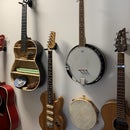Introduction: 1hr Headphone Amp
So you have an electric guitar and you want to hear what it sounds like in your head phones, because it's easy to practice when you don't have mum yelling at you then, this is the perfect instructable for you. Or maybe you have a little ukelele that you put a piezo pickup in, but you want a bit more volume, then again, this is for you.
There are a gazillion things that you can do to make this way better, volume is knob and tone knobs are an easy throw in, but to keep it really basic, lets just stick to this.
Materials:
1X 100k Resistor
1X NPN Transistor (some audio guys will be very specific as to which one they like, but for now, any will do)
1X 100uf Capacitor (or somewhere close to that)
1X 9v Battery clip (or other battery also works, but just won't be as loud)
2X Audio jacks.
Some wire
Soldiering iron (or breadboard it just to see what it is like)
Step 1: Understanding It
So, the idea originally comes from Oddmix, but usually come to instructables first, so it took me ages to find this.
Basically, as I understand it, if you use a bigger resistor, you will get less volume, but the battery will last longer, if you use a smaller resistor, you will get more volume and less battery life, but I may be wrong about that.
In terms of the capacitor, you want one about 100uf, but playing about with different ones will give you some different tones. A bigger capacitor will take out more treble and a smaller capacitor will leave more treble in. So you want something near to 100uf, but if you find that it's too tinny for your liking then take it up a notch and if you find it's not got the presence that you want, then take it down a notch.
Step 2: Soldiering
Many people will go for a fancy board at this stage, I have to admit that it is stronger, lasts longer and makes things easier, but you can get it smaller without one as long as you use some heat shrink or hot glue to stop things from connecting up wrong.
Step 3: Boxing and Extras
Here are some add ons that might take it passed the 1hr mark depending on how far you want to take it.
Additional ideas:
Put it in a Box:
Box it. It will look better and last longer. For the example above, I used an empty cat food can. Any small tin would work. I just liked the idea of a functional junkbot.
Volume knob:
I added a 500k potentiometer on the output cable, this is way too big and is more of a cutoff then a volume knob, so maybe try a 50k one. Connect one edge to the output cable and the other to the ground, the middle continues the output line. This works as a volume knob.
ON/OFF
Add a on/off switch. Connect a switch up between the battery and the circuit. Then you save power when you aren't using it. I've connected an LED in parallel so that I can tell when it's on.
Mono/Stereo switch.
By using a stereo jack for output, I can decide whether the middle post receives any signal by using a switch. This means it can be used as a headphone amplifier in stereo, or a preamp that sends to an amp in mono.
Tone:
I didn't do this, but many guitars have this. Add a 500k potentiometer near your output that connects your output + one on one edge terminal and a capacitor to the earth in the center terminal. This will give you a tone knob. Try different capacitors to see which gives you the type of tone that you want to be able to bring in. You could go all out and put a full EQ on it if you wanted to get fancy.

Participated in the
Full Spectrum Laser Contest 2016











